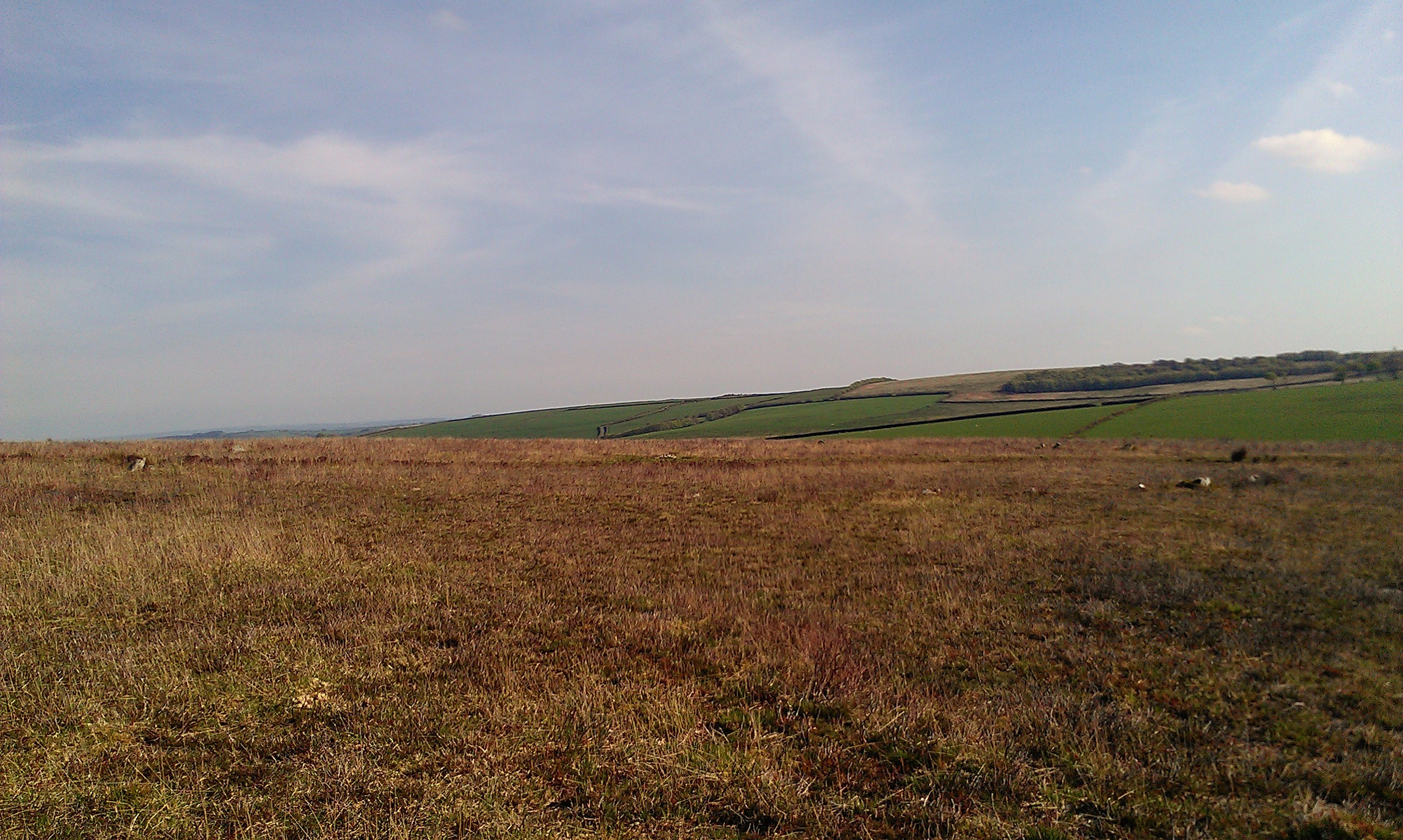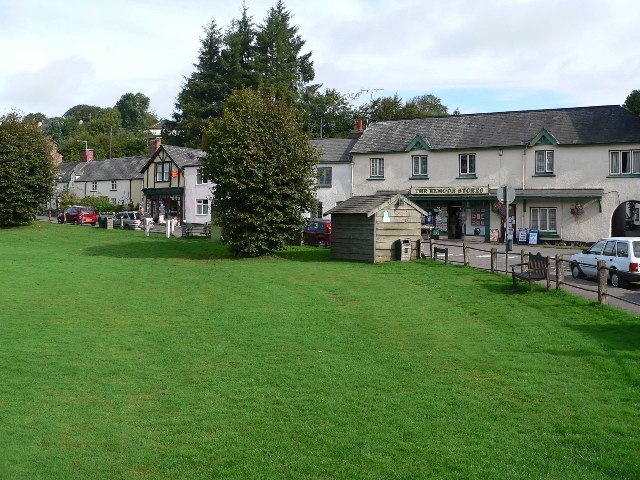|
Withypool Stone Circle
Withypool Stone Circle, also known as Withypool Hill Stone Circle, is a stone circle located on the Exmoor moorland, near the village of Withypool in the southwestern English county of Somerset. The ring is part of a tradition of stone circle construction that spread throughout much of Britain, Ireland, and Brittany during the Late Neolithic and Early Bronze Age, over a period between 3300 and 900 BCE. The purpose of such monuments is unknown, although archaeologists speculate that the stones represented supernatural entities for the circle's builders. Many monuments were built in Exmoor during the Bronze Age, but only two stone circles survive in this area: the other is Porlock Stone Circle. The Withypool ring is located on the south-western slope of Withypool Hill, on an area of heathland. It is about 36.4 metres (119 feet 5 inches) in diameter. Around thirty small gritstones remain, although there may originally have been around 100; there are conspicuous gaps on the no ... [...More Info...] [...Related Items...] OR: [Wikipedia] [Google] [Baidu] |
Withypool
Withypool (formerly Widepolle, Widipol, Withypoole) is a small village in Somerset, England, near the centre of Exmoor National Park and close to the border with Devon. The word Withy means "willow". The civil parish, known as Withypool and Hawkridge, covers , includes the village of Hawkridge and has a population around 201. Withypool is in the Barle Valley on the River Barle. The village lies on the route of the Two Moors Way and the Celtic Way Exmoor Option. To the southwest of the village lie Withypool Common and Withypool Hill. History The area around Withypool has been inhabited since the Bronze Age and the Withypool Stone Circle can still be seen on top of Withypool Hill. The Brightworthy barrows lie on the Common; of three original, two survive. Withypool is mentioned in the Domesday Book as being tended by three foresters: Dodo, Almer and Godric. The parishes of Hawkridge and Withypool were part of the Williton and Freemanners Hundred. In the 14th century, Geoff ... [...More Info...] [...Related Items...] OR: [Wikipedia] [Google] [Baidu] |
Exford, Somerset
Exford is a rural village at the centre of Exmoor National Park, north-west of Dulverton, and south-west of Minehead, in Somerset, England. Less than a mile away is the hamlet of Lyncombe. Situated on the B3224, the main route across Exmoor, it is a small village on the River Exe with activities including hunting, shooting, fishing and horse riding. The centre of the village surrounds a traditional village green, and is home to a post office, general store, car repair shop, youth hostel and primary school as well as a children's play area. The village is on the route of the Samaritans Way South West and the Celtic Way Exmoor Option. History To the east of the village are the prehistoric hillside enclosures of Road Castle and Staddon Hill Camp and to the west is Cow Castle, an Iron Age hillfort. The Domesday Book of 1086 records eight settlements in the parish, five called Exford and the others at Almesworthy (Edmunds homestead), Stone and Downscombe. The parish was part ... [...More Info...] [...Related Items...] OR: [Wikipedia] [Google] [Baidu] |
Round Cairn
A bowl barrow is a type of burial mound or tumulus. A barrow is a mound of earth used to cover a tomb. The bowl barrow gets its name from its resemblance to an upturned bowl. Related terms include ''cairn circle'', ''cairn ring'', ''howe'', ''kerb cairn'', ''tump'' and ''rotunda grave''. Description Bowl barrows were created from the Neolithic through to the Bronze Age in Great Britain. A bowl barrow is an approximately hemispherical mound covering one or more Inhumations or cremations. Where the mound is composed entirely of stone, rather than earth, the term cairn replaces the word barrow. The mound may be simply a mass of earth or stone, or it may be structured by concentric rings of posts, low stone walls, or upright stone slabs. In addition, the mound may have a kerb of stones or wooden posts. Barrows were usually built in isolation in various situations on plains, valleys and hill slopes, although the most popular sites were those on hilltops. Bowl barrows were first ident ... [...More Info...] [...Related Items...] OR: [Wikipedia] [Google] [Baidu] |
Winsford Hill
Winsford is a town and civil parish in the unitary authority of Cheshire West and Chester and the ceremonial county of Cheshire, England, on the River Weaver south of Northwich and west of Middlewich. It grew around the salt mining industry after the river was canalised in the 18th century, allowing freight to be conveyed northwards to the Port of Runcorn on the River Mersey. Winsford is split into three areas: Over on the western side of the River Weaver, Wharton on the eastern side, and Swanlow and Dene. History Early origins Winsford consists of three ancient parishes, St Chads, Over and Wharton, which in the 19th century were combined. The name “Winsford” is of uncertain origin but is thought to derive from Wain’s or Wynne’s and Ford (Mr Wain's crossing point of the river Weaver). The Norman Earls of Chester had a hunting lodge or summer palace at Darnhall in Over parish. There was an enclosed area where deer and wild boar were kept to be hunted by the E ... [...More Info...] [...Related Items...] OR: [Wikipedia] [Google] [Baidu] |
Wam Barrows
WAM or Wam may refer to: Arts * Weisman Art Museum, in Minneapolis * Women's Art Movement, a feminist art organisation in Australia * Worcester Art Museum, in Worcester, Massachusetts People * Arne Wam (born 1952), Norwegian journalist * Svend Wam (1946–2017), Norwegian filmmaker * Wam Kat (born 1956), Dutch political activist and author * Wolfgang Amadeus Mozart (1756–1791), musician Places * Wam, Pakistan, a village of Ziarat District Technology * Warren Abstract Machine, an abstract machine for the execution of Prolog * Web access management, a form of identity management * Web audience measurement, a tool that measures Internet usage in India * Wide area multilateration, a surveillance technology for air traffic management * WAM, a kind of wind wave model Television * WAM (Emirates news agency), a news agency in the United Arab Emirates * WAM!, a cable television channel for children Other * WAM (Wide AC electric mixed), a classification of Indian locomotives ... [...More Info...] [...Related Items...] OR: [Wikipedia] [Google] [Baidu] |
Twitchen Barrows
Twitchen may refer to: *Twitchen, Devon *Twitchen, Shropshire Twitchen is a hamlet in Shropshire, England, on the B4385 south of Purslow and near to Hopton Castle. The southern part of the settlement is called Three Ashes. A mile southeast of Twitchen is the small railway station at Hopton Heath, on the H ... {{geodis ... [...More Info...] [...Related Items...] OR: [Wikipedia] [Google] [Baidu] |
Old Barrow
Old or OLD may refer to: Places *Old, Baranya, Hungary *Old, Northamptonshire, England *Old Street station, a railway and tube station in London (station code OLD) *OLD, IATA code for Old Town Municipal Airport and Seaplane Base, Old Town, Maine, United States People *Old (surname) Music *OLD (band), a grindcore/industrial metal group * ''Old'' (Danny Brown album), a 2013 album by Danny Brown * ''Old'' (Starflyer 59 album), a 2003 album by Starflyer 59 * "Old" (song), a 1995 song by Machine Head *''Old LP'', a 2019 album by That Dog Other uses * ''Old'' (film), a 2021 American thriller film *''Oxford Latin Dictionary'' *Online dating *Over-Locknut Distance (or Dimension), a measurement of a bicycle wheel and frame *Old age See also *List of people known as the Old * * *Olde, a list of people with the surname *Olds (other) Olds may refer to: People * The olds, a jocular and irreverent online nickname for older adults * Bert Olds (1891–1953), Australian rules ... [...More Info...] [...Related Items...] OR: [Wikipedia] [Google] [Baidu] |
Green Barrow
Green is the color between cyan and yellow on the visible spectrum. It is evoked by light which has a dominant wavelength of roughly 495570 nm. In subtractive color systems, used in painting and color printing, it is created by a combination of yellow and cyan; in the RGB color model, used on television and computer screens, it is one of the additive primary colors, along with red and blue, which are mixed in different combinations to create all other colors. By far the largest contributor to green in nature is chlorophyll, the chemical by which plants photosynthesize and convert sunlight into chemical energy. Many creatures have adapted to their green environments by taking on a green hue themselves as camouflage. Several minerals have a green color, including the emerald, which is colored green by its chromium content. During post-classical and early modern Europe, green was the color commonly associated with wealth, merchants, bankers, and the gentry, while red w ... [...More Info...] [...Related Items...] OR: [Wikipedia] [Google] [Baidu] |
Tumulus
A tumulus (plural tumuli) is a mound of earth and stones raised over a grave or graves. Tumuli are also known as barrows, burial mounds or ''kurgans'', and may be found throughout much of the world. A cairn, which is a mound of stones built for various purposes, may also originally have been a tumulus. Tumuli are often categorised according to their external apparent shape. In this respect, a long barrow is a long tumulus, usually constructed on top of several burials, such as passage graves. A round barrow is a round tumulus, also commonly constructed on top of burials. The internal structure and architecture of both long and round barrows has a broad range; the categorization only refers to the external apparent shape. The method of may involve a dolmen, a cist, a mortuary enclosure, a mortuary house, or a chamber tomb. Examples of barrows include Duggleby Howe and Maeshowe. Etymology The word ''tumulus'' is Latin for 'mound' or 'small hill', which is derived from th ... [...More Info...] [...Related Items...] OR: [Wikipedia] [Google] [Baidu] |
Round Barrow
A round barrow is a type of tumulus and is one of the most common types of archaeological monuments. Although concentrated in Europe, they are found in many parts of the world, probably because of their simple construction and universal purpose. In Britain, most of them were built between 2200BC and 1100BC. This was the Late Neolithic period to the Late Bronze Age. Later Iron Age barrows were mostly different, and sometimes square. Description At its simplest, a round barrow is a hemispherical mound of earth and/or stone raised over a burial placed in the middle. Beyond this there are numerous variations which may employ surrounding ditches, stone kerbs or flat berms between ditch and mound. Construction methods range from a single creation process of heaped material to a complex depositional sequence involving alternating layers of stone, soil and turf with timbers or wattle used to help hold the structure together. The center may be placed a stone chamber or cist or in a ... [...More Info...] [...Related Items...] OR: [Wikipedia] [Google] [Baidu] |





